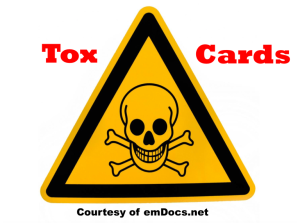Authors: Alexandria Holmes, MD (EM Resident Physician, Carolinas Medical Center, Charlotte, NC) and Christine Murphy, MD (EM Attending Physician; Medical Toxicologist, Carolinas Medical Center, Charlotte, NC) // Reviewed by: James Dazhe Cao, MD (@JamesCaoMD, Associate Professor of EM, Medical Toxicology, UTSW / Parkland Memorial Hospital); Alex Koyfman, MD (@EMHighAK); and Brit Long, MD (@long_brit)

Case:
A 60-year-old male presented to the ED with altered mental status and abdominal pain after ingesting an unknown amount of metformin several hours prior. He was noted to have a GCS of 11, obvious tachypnea, otherwise no clear abnormalities. His initial vital signs were: T 99.6F, HR 90, BP 118/57, RR 30, O2 sat 99%. Laboratory studies demonstrated: sodium 155 mEq/L, potassium 6.4 mEq/L, chloride 111 mEq/L, bicarbonate 7 mmol/L, BUN 19 mg/dL, creatinine 4.3 mg/dL, glucose 93 mg/dL, and lactate 22 mmol/L. An arterial blood gas was obtained, demonstrating pH 6.99, pCO2 33, pO2 79, and bicarbonate 8.
Questions:
- How does metformin toxicity occur?
- What is metformin-associated lactic acidosis? Is it the same as metformin-induced lactic acidosis?
- How does metformin toxicity present clinically?
- What is the management of metformin toxicity?
Background:
- Metformin is an oral biguanide, and classified as an anti-hyperglycemic agent.1 It is the “most commonly prescribed oral anti-hyperglycemic medication in the world”, used both as monotherapy and in combination with other diabetic medications in treatment of type 2 diabetes, gestational diabetes, polycystic ovarian syndrome, hyperinsulinar obesity, and non-alcoholic fatty liver.2
- Metformin:
- Inhibits gluconeogenesis.1
- Promotes peripheral glucose uptake.
- Increases glucagon-like peptide 1 (GLP-1) concentrations and stimulates increased insulin release from the pancreas by increasing GLP-1 receptors.3
- Increases anaerobic metabolism in the intestinal wall.3
- Inhibits fatty acid oxidation.1
- Is excreted primarily unchanged in the urine; metformin clearance is affected by creatinine clearance.1
- The classic laboratory finding in metformin toxicity is severe lactic acidosis.
- As a refresher, the liver, GI tract, and peripheral tissues produce lactate during glycolysis. Lactate is primarily metabolized by the liver (60%), kidney (30%), heart, and skeletal muscle but can also can be oxidized “to carbon dioxide and water by mitochondria to generate energy or converted back to glucose in the liver and kidney” via gluconeogenesis.2
- Metformin causes both increased production and decreased metabolism of lactate through the mechanisms outlined below.

- This is a “type B lactic acidosis.”4
- Lactic acidosis associated with metformin can be further subdivided into two specific clinical entities – MALA and MILA.
What are MALA and MILA?
- The relationship between metformin and lactic acidosis is complex, and although incompletely understood, metformin toxicity and associated lactic acidosis is thought to occur in one of two mechanisms, both of which remain controversial entities5:
Metformin-induced lactic acidosis (MILA)
- Primarily associated with acute accidental or intentional overdoses, however, can also occur in cases of acute kidney injury (AKI) and impaired metformin clearance.2, 5
- The toxic effect depends on metformin concentration and often associated with plasma concentrations > 5 mg/L.2,5
- In MILA, there is no other identifiable cause of lactic acidosis.
- Death is less common than in MALA, and likely results from cardiovascular collapse caused by severe refractory acidosis.2,5
Metformin-associated lactic acidosis (MALA)
- Occurs from combination of normal or elevated plasma metformin concentrations and a secondary insult that alters lactate production/clearance.
- More likely to occur in patients with acute renal impairment from other medical illnesses/processes like dehydration or surgery, and there is an increased risk in elderly patients with decreased glomerular filtration rates.2
- These patients are more frequently hemodynamically unstable and have a higher mortality than those with MILA (30-50%).2,5
- The distinction between metformin-induced and metformin-associated lactic acidosis is often blurred but management for both entities is the same.
Clinical Presentation:
- Mild toxicity: non-specific symptoms including nausea, vomiting, diarrhea, abdominal pain, pancreatitis, malaise, myalgias, and dizziness.1
- Severe toxicity:
- Onset may be subtle with non-specific symptoms
- Patients may also develop encephalopathy, blindness, shortness of breath, hypothermia, hypotension, and death.1
- Physical exam may show tachycardia, hypotension, tachypnea, and/or altered mental status.
- Laboratory findings:
- Severe metabolic acidosis with elevated anion gap
- Elevated lactate
- Hypoglycemia (very rarely)
- Has been reported in a few cases in the literature
How do you make the diagnosis?
- There is not one clearly defined minimum dose of metformin that leads to toxicity.
- In acute overdose, lethal dose has been associated with greater than 5 g in adults, greater than 100 mg/kg in pediatrics.
- Suspicion for the diagnosis should be derived from the history, clinical picture, and lab results. To identify an accidental overdose, review the patient’s medication regimen/habits thoroughly.
- Some define metformin toxicity as a lactate greater than 5 mmol/L and pH less than 7.35 in association with metformin exposure.4
- If a history of overdose is not clear, clinicians should have high index of suspicion in patients with a known or suspected metformin exposure (including therapeutic use), an elevated lactate, and:
- Patients with comorbid condition:
- Renal insufficiency
- Liver disease
- Heart failure
- Active alcohol abuse
- Any acute presentation with decreased tissue perfusion, hemodynamic instability, or hypoxic state (cardiorespiratory insufficiency, septicemia)
- Recent IV iodinated contrast media use in a patient with a low GFR who continued to take their metformin following the study
- In patients with a GFR less than 30 mL/min//1.73m2, the American College of Radiology recommends holding metformin for 48 hours after receiving IV iodinated contrast material6
- Patients with comorbid condition:
- Work-up:
- Initial labs should include glucose, basic metabolic panel, arterial or venous blood gas (ABG or VBG), serum lactate concentration.
- Consider a complete blood count, liver function tests and PT/INR if concerned about underlying liver dysfunction.
- Consider acetaminophen and salicylate concentrations to evaluate for co-ingestion in intentional overdose.
- A serum metformin concentration is unhelpful clinically in most cases, as it has not been found to correlate with severity or outcome and is a send out lab at most hospitals.2
- If exam or baseline labs suggest Vitamin B12 deficiency, can consider obtaining a Vitamin B12 concentration (should not be routine part of work-up of metformin toxicity).
Management:
- The mainstay of treatment is good systematic and supportive care.
- Patients should be monitored closely, as clinical worsening can occur rapidly
- Consider early consultation with toxicologist and nephrologist.
- Decontamination: Consider activated charcoal early following an acute ingestion in patients that can protect their airway or are intubated.1
- Airway management: Patients with metformin toxicity rarely require intubation, but it is important to remember tachypnea may reflect compensation for metabolic acidosis as opposed to impending respiratory failure, and clinicians should be conscious of ventilator rate settings (i.e. don’t set the ventilation rate too low).
- Hypotension:
- IV fluids, vasopressor therapy
- Persistent hypotension suggests profound toxicity, in which case hemodialysis is often necessary.
- Hypoglycemia:
- Dextrose supplementation
- If hypoglycemia occurs, evaluate for other causes such as concurrent insulin or sulfonylurea exposure, as metformin alone rarely causes hypoglycemia.
- Metabolic acidosis:
- Sodium bicarbonate usage for acidosis is controversial.
- Can consider IV sodium bicarbonate if serum bicarbonate concentration less than 5 mEq/L1.
- Dose: 1-2 mEq/kg IV bolus, then infusion titrated to pH greater than 7.2.
- Hemodialysis:
- In cases of severe metformin toxicity, dialysis can be utilized.4
- Intermittent hemodialysis is preferred initially; continuous renal replacement therapy may be considered if hemodialysis is not feasible.
- EXTRIP’s criteria for dialysis include any one of the following4:
- Severely elevated lactate greater than 20 mmol/L
- Severe metabolic acidosis with pH less than or equal to 7.0
- Failure to improve (pH, lactate, clinical status) with standard supportive care within 2-4 hours
- Dialysis may also be considered under the following conditions according to EXTRIP4:
- Elevated lactate greater than 15 mmol/L
- pH 7.0-7.1
- Shock
- Decreased level of consciousness
- Comorbidities: kidney injury, liver failure with coagulopathy, encephalopathy
- Disposition:
- Asymptomatic acute ingestions:
- 4–6-hour observation period for immediate-release overdose, 8-12-hour observation with extended-release formulations; medically clear if remain asymptomatic without metabolic acidosis, lactate elevation, hypoglycemia, or renal injury1.
- Some recent studies have suggested longer observation times up to a minimum of 12 hours following acute overdose.7
- Symptomatic ingestions with mild elevation of lactate and increased anion gap:
- Can medically clear if all symptoms and laboratory abnormalities resolve after a period of observation with instructions to discontinue metformin, get follow-up labs with primary care physician if they are prescribed metformin.
- Observation or hospital admission if symptoms or laboratory abnormalities unresolved.
- Severe Toxicity:
- Admission to an intensive care unit
- Trend electrolytes and lactate frequently (Ex: every 2 hours or less)
- Trend ABG/VBG
- Consider hemodialysis
- Asymptomatic acute ingestions:
Case Follow-up
Soon after presentation, the patient became hypotensive. He was started on a sodium bicarbonate infusion, vasopressors, and ultimately, hemodialysis. After 2 days of intermittent hemodialysis, his acidosis improved, and his pressor requirement decreased. Despite a complicated hospital course, he survived his overdose.
Clinical Pearls:
- Although metformin toxicity is uncommon, it does occur with enough frequency and with significant enough morbidity to require vigilance among emergency physicians.
- Metformin toxicity exists as MILA and MALA. MILA is associated with acute overdose, while MALA is related to effects of normal or elevated metformin concentration in the setting of secondary stressor. MALA has a higher morbidity and mortality compared to MILA.
- Treatment for both MILA and MALA is supportive, including IVF and vasopressor support as needed, and often requires hemodialysis.
References:
- Hoffman RS, Nelson LS, Goldfrank LR, Howland MA, Lewin NA, Smith SW. Goldfrank’s Toxicologic Emergencies, Eleventh Edition. McGraw-Hill Education; 2019.
- DeFronzo R, Fleming GA, Chen K, Bicsak TA. Metformin-associated lactic acidosis: Current perspectives on causes and risk. Metabolism. 2016;65(2):20-29.
- Hostalek U, Gwilt M, Hildemann S. Therapeutic Use of Metformin in Prediabetes and Diabetes Prevention. Drugs. 2015;75(10):1071-1094.
- Calello DP, Liu KD, Wiegand TJ, et al. Extracorporeal Treatment for Metformin Poisoning: Systematic Review and Recommendations from the Extracorporeal Treatments in Poisoning Workgroup. Crit Care Med. 2015;43(8):1716-1730.
- Corchia A, Wynckel A, Journet J, et al. Metformin-related lactic acidosis with acute kidney injury: results of a French observational multicenter study. Clin Toxicol . 2020;58(5):375-382.
- ACR Manual on Contrast Media, 2021. ACR Committee on Drugs and Contrast Media; American College of Radiology. Metformin; 44-46. Available at: https://www.acr.org/-/media/ACR/Files/Cinica-Resources/Contrast_Media.pdf. Accessed 8/6/2021
- Theobald J, Schneider J, Cheema N, DesLauriers C. Time to development of metformin-associated lactic acidosis. Clin Toxicol . 2020;58(7):758-762.






